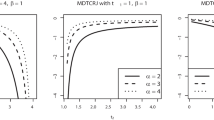Abstract
To overcome the drawbacks of Shannon’s entropy, the concept of cumulative residual and past entropy has been proposed in the information theoretic literature. Furthermore, the Shannon entropy has been generalized in a number of different ways by many researchers. One important extension is Kerridge inaccuracy measure. In the present communication we study the cumulative residual and past inaccuracy measures, which are extensions of the corresponding cumulative entropies. Several properties, including monotonicity and bounds, are obtained for left, right and doubly truncated random variables.



Similar content being viewed by others
References
Asadi M, Zohrevand Y (2007) On the dynamic cumulative residual entropy. J Stat Plan Inference 137:1931–1941
Baratpour S (2010) Characterizations based on cumulative residual entropy of first-order statistics. Commun Stat Theory Methods 39(20):3645–3651
Barlow RE, Proschan F (1975) Statistical theory of reliability and life testing: probability models. Holt, Rinehart and Winston, New York
Chamany A, Baratpour S (2014) A dynamic discrimination information based on cumulative residual entropy and its properties. Commun Stat Theory Methods 43(6):1041–1049
Cox DR, Oakes D (1984) Analysis of survival data. Chapman & Hall, New York
Di Crescenzo A (1999) A probabilistic analogue of the mean value theorem and its applications to reliability theory. J Appl Probab 36(3):706–719
Di Crescenzo A (2000) Some results on the proportional reversed hazards model. Stat Prob Lett 50(4):313–321
Di Crescenzo A, Longobardi M (2009) On cumulative entropies. J Stat Plan Inference 139:4072–4087
Di Crescenzo A, Longobardi M (2013) Stochastic comparisons of cumulative entropies. Stochastic orders in reliability and risk, Lecture Notes in Statistics, vol 208. Springer, New York, pp 167–182
Di Crescenzo A, Longobardi M (2015) Some properties and applications of cumulative Kullback–Leibler information. Appl Stoch Models Bus Ind. doi:10.1002/asmb.2116 (online first)
Gupta RC (2007) Role of equilibrium distribution in reliability studies. Probab Eng Inf Sci 21:315–334
Gupta RC, Gupta RD (2007) Proportional reversed hazard rate model and its applications. J Stat Plan Inference 137:3525–3536
Kerridge DF (1961) Inaccuracy and inference. J R Stat Soc Ser B 23:184–194
Khorashadizadeh M, Rezaei Roknabadi AH, Mohtashami Borzadaran GR (2013) Doubly truncated (interval) cumulative residual and past entropy. Stat Probab Lett 83:1464–1471
Kundu C, Nanda AK (2015) Characterizations based on measure of inaccuracy for truncated random variables. Stat Pap 56(3):619–637
Misagh F, Yari GH (2011) On weighted interval entropy. Stat Probab Lett 81:188–194
Misagh F, Yari GH (2012) Interval entropy and informative distance. Entropy 14:480–490
Navarro J, Ruiz JM (1996) Failure rate functions for doubly truncated random variables. IEEE Trans Reliab 45:685–690
Navarro J, del Aguila Y, Asadi M (2010) Some new results on the cumulative residual entropy. J Stat Plan Inference 140:310–322
Park S, Rao M, Shin DW (2012) On cumulative residual Kullback–Leibler information. Stat Probab Letters 82:2025–2032
Rao M (2005) More on a new concept of entropy and information. J Theor Probab 18(14):967–981
Rao M, Chen Y, Vemuri BC, Wang F (2004) Cumulative residual entropy: a new measure of information. IEEE Trans Inf Theory 50(6):1220–1228
Sankaran PG, Gleeja VL (2008) Proportional reversed hazard and frailty models. Metrika 68(3):333–342
Shaked M, Shanthikumar JG (2007) Stochastic orders. Springer, New York
Shannon CE (1948) A mathematical theory of communications. Bell Syst Tech J 27:379–423, 623–656
Sunoj SM, Sankaran PG, Maya SS (2009) Characterizations of life distributions using conditional expectations of doubly (interval) truncated random variables. Commun Stat Theory Methods 38:1441–1452
Acknowledgments
We thank an anonymous referee for his/her useful comments and suggestions on the earlier version of the paper.
Author information
Authors and Affiliations
Corresponding author
Additional information
The work of C. Kundu is supported by Department of Science and Technology, Government of India (Ref. No. SR/FTP/MS-016/2012) and the research by A. Di Crescenzo and M. Longobardi is partially supported by GNCS-INdAM and Regione Campania (Legge 5).
Rights and permissions
About this article
Cite this article
Kundu, C., Di Crescenzo, A. & Longobardi, M. On cumulative residual (past) inaccuracy for truncated random variables. Metrika 79, 335–356 (2016). https://doi.org/10.1007/s00184-015-0557-5
Received:
Published:
Issue Date:
DOI: https://doi.org/10.1007/s00184-015-0557-5
Keywords
- Cumulative residual (past) entropy
- Dynamic cumulative residual (past) inaccuracy
- Inaccuracy
- Interval cumulative residual (past) inaccuracy




